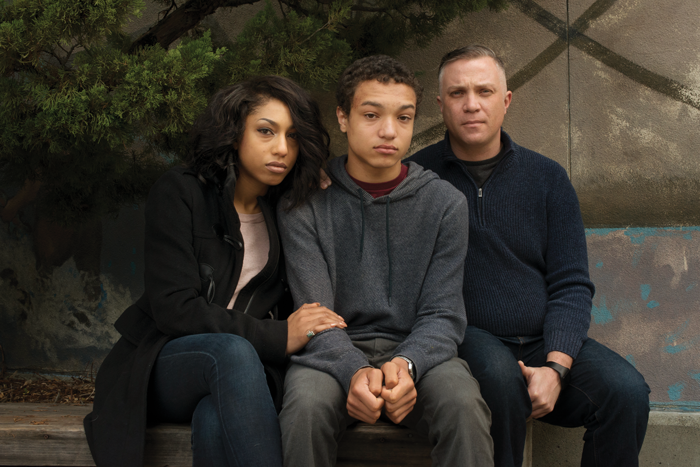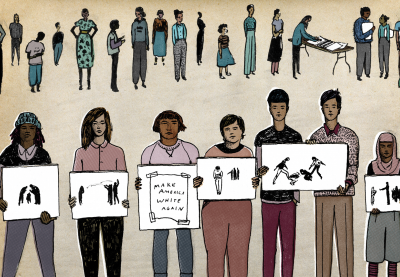“I could’ve lost my kid,” Raquel Mack says.
For two years, starting at the onset of football practice in 2013, her son Evan faced targeted racial harassment at Analy High School in California’s Sonoma County. Open and repeated use of the n-word by white teammates escalated into personally threatening behavior, in person and on social media. Despite the evidence and multiple requests for help, the abuse continued. Evan was left socially isolated, academically strained and feeling unsafe.
Editor’s Note
This story was amended after publication to include the work of Kiori Jordan-Marquering and Saturday Morning Coffee.
In September of 2015, his parents removed him from the school. But they kept fighting for him. In February of 2016, they officially filed a complaint with the Department of Education, citing Title VI of the Civil Rights Act of 1964. That September, three years after the first incident, the Office for Civil Rights found Analy High School in violation of Title VI for failing to “end the harassment, eliminate any hostile environment that was created, prevent its recurrence, and remedy the effects of the harassment on the Student.”
Based on her experience—and what she heard from other families when Evan’s story went viral—it was clear to Raquel Mack that neither educators nor families knew what responsibilities public schools held under Title VI, let alone the processes for holding schools accountable.
But that was about to change.
The more Mack told her story, the more people she met who had similar experiences. She partnered with fellow Analy parent Kiori Jordan-Marquering to launch Saturday Morning Coffee, a weekly meeting group to discuss the issue of discrimination in schools, leading her to meet social media strategist Celeste Winders. Through Black Lives Matter activist work, she already knew communications designer and strategist Johanna Pino. She met D’mitra Smith when she reached out to the Sonoma County Commission on Human Rights, of which Smith is vice chair. Out of necessity, a coalition formed: Save Your VI—an organization determined to raise awareness of students’ Title VI rights among young people, families and educators.
So, What Is Title VI, Anyway?
Title VI of the Civil Rights Act of 1964 represents one of the biggest victories of the civil rights movement. The law prohibits discrimination based on race, color, ethnicity or national origin by any program that receives federal funds.
The law requires schools to protect students from racial harassment and take immediate action to repair harm when harassment takes place. In fact, it requires schools to address any form of racial discrimination, including disparate suspension rates; unfair discipline practices; unequal access to courses; or any action that impairs students’ education because of their race or ethnicity.
Every public school in the United States is bound by Title VI, but its reach goes far beyond that. The law helped desegregate many aspects of public life in the U.S., including public transportation, parks and hospitals. For those who participated in bus boycotts and sit-ins, and for those who took the first courageous steps into newly integrated schools, this law is a legacy—a product of their sacrifice and resolve.
So when D’mitra Smith says this law “was paid for in lives,” she doesn’t exaggerate.
No person in the United States shall, on the ground of race, color, or national origin, be excluded from participation in, be denied the benefits of, or be subjected to discrimination under any program or activity receiving Federal financial assistance.
—Title VI of the Civil Rights Act of 1964
Title VI Today
Enforcement of Title VI falls at the feet of the Department of Education’s Office for Civil Rights. Catherine Lhamon—currently the chair of the U.S. Commission on Civil Rights—served as the assistant secretary over the OCR from 2013 to 2016.
The role of the OCR, Lhamon says, “is to investigate every complaint over which it has jurisdiction [and] ensure that the office gets to the bottom of where facts actually are and whether schools need to take steps to address that student’s rights.”
Lhamon has seen the racism that can fester in a school and claim students as victims, and stories from her time at the Office for Civil Rights clearly stick with her. She recalls students barred from participating in school programs because they wore hijabs and a boy pelted with pennies and tormented about his “Jew nose.” She remembers a young Latinx student, beaten by his peers. “Welcome to America,” they said.
Only a fraction of cases reported to the OCR are ever resolved. In 2016, that number was 57—out of 2,439 complaints covered by Title VI. Today, more than 1,500 pending Title VI complaints remain under OCR investigation. Families seeking justice for children who have been victimized by discrimination or harassment may not find it.

To make things worse, Lhamon says she’s seen a shift in the office since her departure. “The clearest indicators to date in this administration are that the administration has turned its back on meaningful civil rights enforcement,” she says. “And that includes at the Department of Education.”
Enter Save Your VI, a group working to educate young people, families and educators about the Title VI complaint process since Mack and her colleagues formed it in 2017. Personal experience informs the work of Save Your VI. The activists involved know firsthand that resolving a Title VI complaint isn’t easy.
“My whole life was turned upside down just trying to get some accountability for my son,” Mack recalls. “It’s very important that parents and caregivers understand that, from the very beginning, the cards will be stacked against them. And they need to understand how that system works.”
This means making sure families know to document everything, including hate incidents and any correspondence with school officials. This also means knowing complaint procedures at the district and state levels. This means recognizing that justice isn’t inevitable, but the fight is vital.
Title VI advocates underscore the importance of holding the federal government accountable to its promise written in the Civil Rights Act. If we don’t, they fear, the absence of complaints could justify the dissolution of the office meant to resolve them.
“I refuse,” Smith says of the law paid for in lives, “to let this pass into oblivion.”
Saving Our VI
“The number one thing is awareness,” Mack says, describing the work of Save Your VI. Stakeholders need to know, first and foremost, that this pivotal civil rights law exists.
On the organization’s website, flyers offer classroom-friendly reminders of what students and teachers can do when they see racial discrimination happen at school. Toolkits are tailored for students, families and educators. A checklist reminds school leaders of their legal obligations—and how to uphold them.
Save Your VI also does work on the ground, participating in workshops, consulting with parents and educators directly, and advocating for the enforcement of Title VI and similar, state-level laws. This includes pressing state legislators to push for more transparency in schools and for mandatory Title VI coordinators.
Celeste Winders, like Mack, has a painful understanding of the need for a twofold fight for Title VI—to preserve it from the bottom up and demand its enforcement from the top down. Her son was subjected to repeated racial slurs at school. The OCR investigation into his school’s alleged negligence has been going on nearly two years due to a backlog at the federal level and noncompliance at the local level.
“At Save Your VI, obviously, we’re willing to shoot straight for the top and fight at that level,” Winders says, “But we really need the boots on the ground of parents, activists and [teachers] really holding their school districts accountable and holding their states accountable.
“Because while we fight the federal battle, we have to protect kids on the ground in the schools.”
2,439
In 2016, the OCR received 2,439 complaints of discrimination based on race or national origin.
22.2%
542 (22.2%) of those complaints included racial harassment.
1,500+
Today, more than 1,500 pending Title VI complaints remain under OCR investigation.
17%
Harassment complaints based on race, color, and national origin have increased 17 percent since 2011.
How Educators Can Help
Catherine Lhamon believes educators have a role to play in defending Title VI. “Having educators, parents and students stand in leadership for nondiscrimination principles persists as an incredibly important way of ensuring the safety net for all of our students.”
Winders notes that many teachers have confided in her “that when they see these things happen in the hallways and in the classrooms, they’re not sure what to do.” But resources from Save Your VI and former resolution agreements from the OCR can offer a roadmap. They show educators how to respond if they see racial harassment occur, how to report it, how to document it, and how to protect the student and provide comfort.
Educators can also work to ensure students’ families have ready access to their rights under Title VI. Many families advocating for students are met with the same defense: “The school or district will tell them … ‘This is totally out of the blue. This never happens here,’” Mack says. “It’s always a lie.” By keeping track of incidents, and by having the law and the complaint process readily available and accessible, educators can act as advocates.
Those facing dismissive district leaders or administration have the power and legal standing to press for more accountability, Winders says. She recommends looking for a policy that specifically addresses discrimination—not just bullying—due to a student’s race or ethnicity. “If I was an educator, I would want to make sure that that policy exists,” Winders says. “And that there’s training for myself and my colleagues who are in the classrooms.”
Smith adds, “At the end of this, we’re trying to protect the students, that little girl or that little boy that feels like, ‘Why should I be engaged in this education? I’m not safe here.’ Empowering teachers, who are the ones that are with those students all day when the parents are not, is the best way that we can really start to increase their protection.”
Collins is the senior writer for Teaching Tolerance.
The Time is Now
Why is Save Your VI fighting for a law at the moment the office responsible for its enforcement faces cuts and backlogs? Because the mission is more important than ever. Teaching Tolerance found that incidents of hate and bias jumped during the 2016 election and have continued to increase. Since October 2017, TT has tracked over 700 reported incidents of hate directed at students and staff because of their race, religion, ethnicity, sexual orientation, gender identity or perceived immigration status.

